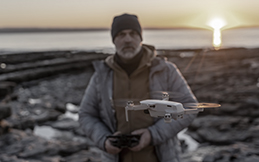The introduction of drones certainly has made an impact on our lives. They’re continually surprising us with amazing new smart features and all the 80’s kids who grew up with radio controlled toys – are just in awe of drones. But as a Video Producer and owner of a video production company, I’ve witnessed enormous positive changes in our industry due to the introduction of drones.
The uses of a drone in the capture of video and image can be clearly be understood by anyone. Dazzling shots of vistas, landscapes, landmarks or architecture from way up high, or shot from a new and innovative perspective is enough to make anyone say wow. These shots instantly lift the production values of a video.
But I felt the game changer in our industry was in some of the efficiencies that drones created. Occasions where cranes or helicopter shots were required – can now be replaced by a single operator with a drone. Or some shots that traditionally required metres and metres of track and dollies to be setup – can also, now be achieved with a single operator with a drone.
On set, we’d have to engage production specialist crews, with large amounts of equipment – just to setup for some of these crane or jib shots. For aerial video production, we’d need to hire in a helicopter, a pilot and aerial camera operator. And in these scenarios, a Video Producer or agency steps aside and hands these components of the production over to the specialists.
They are absolutely specialised and extremely good at their craft but as a hands-on collaborative creative, to not be involved is a strange feeling. Not to mention some of the environmental impacts of production being carries out in this way. The usage of fuel, power, time and extra crew members all impact a production budget and our planet.
Drones for video production have created great efficiencies and have created so many more opportunities for brands to utilize exciting content. It’s not just reserved for brands. Businesses and organisation also have access to these types of content now.
In a world where expensive media and production was only reserved for large companies and only seen on Television or film; it is now accessible to anyone and can be viewed and consumed in so many different spaces.
There are compliance rules that need to be followed for the flight of drone within Australia, that are set by the Civil Aviation Safety Authority (CASA). Commercial drone operators (this includes those flying small drones of a low weight to capture video) are required to carry a valid Remote Piloted Aircraft Operated Certificate (ReOC). Under the guidelines, drones cannot be flown after dark, indoors, in unfavourable weather conditions and in close proximity to people. This level of compliance ensures that there are equipped people operating drones for production purposes and it also doesn’t rule out all production specialist roles mentioned earlier in the shot types.
As a producer, I find the changes to our business community and industry with the introduction of drones very exciting and I see it as a huge positive.
It also means that on many productions, it reduces the amount of time that I’m standing by the sidelines to watch our productions get made by others. More often I’m able to have an active part in production throughout.
And most importantly, we can deliver our customers video and content of a very high level, all whilst using game-changing equipment.
This article also featured in Business Game Changers Magaine

